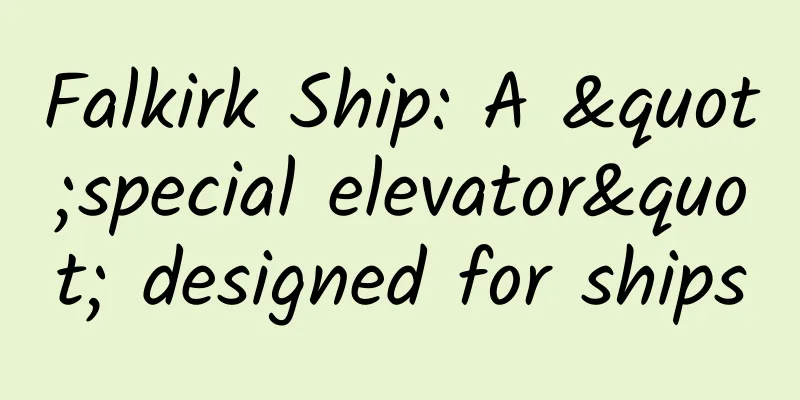Falkirk Ship: A "special elevator" designed for ships

|
With the advent of elevators, our lives have become much more time-saving and labor-saving. If there were no elevators, we would have to spend a lot of time climbing stairs every day, and the world's tallest buildings would not appear. That’s right, today we are going to talk about elevators, but this elevator is a bit "special" because it is an "elevator" designed for ships. In Falkirk, Scotland, there is an "elevator" specifically for serving ships, and its name is the Falkirk Wheel. When I saw this design, my first reaction was coooool~, but then I looked at it again and realized that apart from the peculiar shape, there didn’t seem to be anything special about it. But it solves the epic problem between the two canals!! First, let us understand the geographical location of the Falkirk Ship. The Falkirk Wheel is located at the intersection of the Forth and Clyde Canal and the Union Canal, but awkwardly, the two canals are not connected because there is a drop of about 25 meters between the two canals. The boats on the two canals can be said to be "I live at the head of the Yangtze River, you live at the tail of the Yangtze River". Before the Falkirk was designed and built, ships could only travel from one canal to another by passing through a series of cumbersome locks. The locks in the picture above basically have a water tank with a gate at each end. The water tank releases water into the lock, allowing ships to enter, and then releases water to the next lock... However, this series of water storage and release operations must wait until the ship reaches its destination. You can imagine how great the time cost is. To solve this problem, RMJM Architects designed the Falkirk Wheel. This big guy consists of a pair of large rotating wheels with a symmetrical, closable water tank on each side. With the Falkirk Ship, a ship-only "elevator", ships on one side of the canal can be transported to the other canal in five minutes... What is even more incredible is that even though such a huge device is loaded with hundreds of tons of water and the hull, the electricity required to rotate it to complete the work is only the electricity required to boil eight household electric kettles (1.5kWh). So how does the Falkirk Wheel, this time-saving and energy-saving machine, work, and what principles does it rely on? At this time, we need to thank Archimedes (who doesn't like taking baths) for not forgetting to observe life while taking a bath, which gave us Archimedes' principle - an object immersed in a stationary fluid (gas or liquid) is subject to a buoyancy equal to the weight of the fluid displaced by the object. The Falkirk Wheel was designed so that the weight on each side was equal, according to the laws of buoyancy. The wheel was perfectly balanced, so a relatively small amount of power was needed to turn the large wheel (which explains why the power consumption was so low). On this basis, a boat entering a tank full of water will inevitably displace an amount of water equal to its weight. Therefore, no matter whether the size and weight of the boats in the two tanks are the same, it will not affect the balance of the wheel. The total weight of the water in the tanks on both sides and the boats is always equal. When a ship needs to move from a high canal to a low canal or from a low place to a high place, after the ship enters the water tank, a certain amount of water will be discharged, and then the water tank will be closed; then the large wheel will slowly rotate half a circle, and the gears will run to smoothly transport the ship in the water tank to the desired river channel, thus realizing the exchange. At the same time, the designers also installed five gears on the beam, which are simply the icing on the cake. When the Falkirk Wheel is working, it is a process in which five gears of different sizes continuously mesh and operate. But only the two small wheels that "connect the upper and lower parts" are actually working, and their rotation drives the other gears to rotate. This ensures that the Falkirk Wheel is extremely stable when it rotates, and that the water it carries does not spill out, and that the ship and the people and objects on board do not fall out. Interestingly, the solution to the problem of the wheel rotating while the load does not rotate was thought up by the designer when he was playing with his daughter. At the time, the engineers racked their brains to make the load "still". The Falkirk Wheel is currently the only rotating ship lift in the world and is hailed as a wonder of 21st century engineering. It makes imagination come true and allows ships to take a convenient elevator. |
Recommend
When a typhoon strikes, how should offshore wind power respond?
Compared with onshore wind power, offshore wind p...
Want to be the next hit? See Youtui CEO tell you how to double your app users through social media promotion
From the explosion of Faceu and Moman Camera to t...
In this vast sea of people, where are your target customers?
We know that the first step of operation is posit...
How can content operations advance from zero foundation to the workplace?
First, let’s interpret the first part: The past a...
Android M system will natively support fingerprint recognition
[[134716]] On the morning of May 22, Google I/O c...
The fighting power of "autumn mosquitoes" is off the charts. Let's have a "mosquito-killing" storm! See the "vicious" flowers
After finally getting through the summer mosquito...
What can a public account do well in the early stages to accelerate user growth?
First of all, I want to say that the essence of b...
5,000 words to explain Xiaohongshu’s popular areas and monetization models!
In just 3 months, with less than 500 fans on Xiao...
Tesla is working hard to increase production by building open-air sheds and using tape for repairs
In a recent report by CNBC, Tesla employees said ...
Teach you how to write a perfect product promotion plan in 6 steps!
I have no idea how to promote a new product every...
The evolution of life prefers a single chirality: Why are proteins almost all "left-handed"?
The important substances that make up life have t...
A quick guide to time management: Manage your time and become the master of it
Everyone is a manager of time, but most people ju...
Google's new system Fuchsia, which is quietly developing, will be the end of Android
The competition in mobile operating systems is qu...
How to choose server rental?
With the rapid development of China's Interne...
Check out the three common explosive points of “screen-sweeping” marketing!
The author reviewed and sorted out nine marketing...









